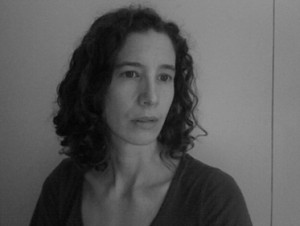Featured Fig is an ongoing column showcasing Les Figues authors. Frances Richard is the author of Anarch. (Futurepoem, 2012), The Phonemes (Les Figues Press, 2012) and See Through (Four Way Books, 2003), as well as the chapbooksShaved Code (Portable Press at Yo-Yo Labs, 2008) and Anarch. (Woodland Editions, 2008). She writes frequently about contemporary art and is co-author, with Jeffrey Kastner and Sina Najafi, of Odd Lots: Revisiting Gordon Matta-Clark’s “Fake Estates” (Cabinet Books, 2005). Currently she teaches at the California College of the Arts in San Francisco.
1. Tell us a little bit about your aesthetic inclinations?
I am deeply satisfied by work that extends a long way into the playful joy of manipulating its media, that gets beguiled by spatial, sonic, etymological or chromatic (etc.) progressions, gives in to the fascination of arranging and rearranging the matter of which it is made—and then looks up from itself, breaks the spell of self-generating abstract relationships, and drops back into a simpler, more mundane diction, the blunt lingua franca of “I do (feel, notice, desire, struggle with) this, I do (don’t, can’t, work at, wonder) that.” Though often I don’t know who “I” is in either clause.
2. Where did you come from and are you happy that you’re no longer there?
I am from San Francisco by birth and Chicago by childhood experience. For many years in New York I mourned for the outline of the Headlands in that particular planar, silvery, Pacific light. And recently I had a Proustian experience triggered by the smell of diesel mixed with cinnabons and perfume in O’Hare. I’m glad to have those experiences?
3. What does your work demand? What does it offer?
Someone just told me that my work is “acrobatic,” and I liked that a lot. Someone else used the word “nutritious,” which was also very gratifying.
4. Where do you do what you do?
In the sunniest, quietest, cleanest, greenest-out-the-window place available. I am a triple Virgo.
5. If push came to shove…
Do you want to be right, or do you want to be happy?
6. Please tell us about beauty, belief or bawdry. You may begin.
Belief, the earnest and dutiful middle child, gets short shrift, reads in the corner, stays home and placates the narcissists. She is quietly yet firmly horrified by her alleged compatriots as portrayed in retail politics. Actually, it’s the almighty-dollar versions of luscious surface and libidinous foldings that freak her out; belief’s homely superpower is that she morphs into beauty and bawdry both at a moment’s notice.
7. As Gertrude Stein says “let us why why.” Please proceed.
In “Dinner,” in Tender Buttons, Stein says “let us why way.” In this poem, she also says:
It was a time when in the acres in late there was a wheel that shot a burst of land and needless are niggers and a sample sample set of old eaten butterflies with spoons…
Is this an American fantasy⎯remembered or conjured into being out of French renegade domesticity—of a time when in the acres lately, i.e. recently, imagined as wholly open there was a wagon wheel, a shotgun-toting pioneer who burst into expansive lands that Stein defines (in The Making of Americans) as shaped particularly by speed⎯and, in those time-spaces, slavery and soul-destroying race-paranoia were needless? Or⎯since words have consequences for bodies politic⎯it was needless to attempt to kill with the weapon of invidious naming? And let us, now, at dinner together, interrogate that way of being? Meanwhile door-to-door salesmen and simple memory-catalogues peddle old moth-eaten lace curtains and silver-plated spoons?
I’d like to put the best face on this, since I consider Stein A Mother of Us All. But basically I’m bummed, because I can’t help but imagine that she simply felt entitled to use the word “nigger” as a sonic shape and cultural trope without much thought. So, as writers, let’s say we make why a transitive verb to apply to those ways of working and thinking to which we are beholden…
8. What does art do to you?
See above, I guess.
9. Who (or what) do you admire?
I admire intelligent kindness. Non-brutal stick-to-it-iveness. And so many poets, and artists in many media including meditation and activism, that I won’t try to list them.
10. What is a good question? What questions do you ask?
Two general questions I ask a lot are, “Why is that?” and “Do you know what I mean?” (maybe the first translates to, “Do I know what you mean?”) I also like Jennifer Calkins’s specific questions.
11.What do you find deeply satisfying?
See #1.
12. What are your favorite kinds of figs?
A fig is like an edible geode!
***
FRANCES RICHARD‘S second volume of poems, The Phonemes, is newly out from Les Figues Press; later this year Futurepoem will release a third book titled Anarch. She is the author of See Through (Four Way Books, 2003) and the chapbooks Anarch. (Woodland Editions, 2008) and Shaved Code (Portable Press at YoYo Labs, 2008). With Jeffrey Kastner and Sina Najafi she is co-author of Odd Lots: Revisiting Gordon Matta-Clark’s “Fake Estates” (Cabinet Books, 2005). She has been a member of the editorial teams at Fence and Cabinet magazines, writes frequently about contemporary art, and teaches at Barnard College and the Rhode Island School of Design. She lives in Brooklyn.
***

Comments are closed.